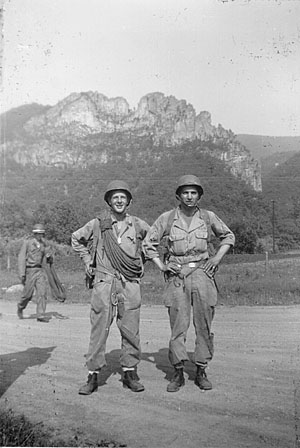Climbing to Victory
WWII Assault Training at Seneca Rocks
By Robert C. Whetsell
In the summer of 1943, 32 army officers and enlisted men from the Mountain Training Center at Camp Hale, Colorado, embarked on a memorable journey to the wilds of West Virginia. Their mission was to set up and run the army’s only low altitude assault climbing school, located at the base of Seneca Rocks in Pendleton County and operated as part of the West Virginia Maneuver Area (WVMA).
These GI’s were an elite cadre of world class mountaineers known as the Mountain Training Group (MTG), sometimes called ski troopers or snow soldiers. The 13th Corps of the U.S. Army oversaw the WVMA from headquarters in Elkins. The climbing school at Seneca and a pack-mule transport school in Tucker County were two of several training programs unique to the five-county WVMA. [See “The Mule School: The West Virginia Home Front in World War II,” by H.L. Hames; Spring 1991.] The area was selected for its rugged isolation and similarities to terrain found in northern Italy, the expected destination for those engaged in the training. Seneca Rocks was going to war.
For Sergeant Sylvan “Woodie” Waldrip, a 23 year-old climbing instructor, the detail was an eye opening and life-changing experience. A native of northern California, Woodie documented that time in a 15 page memoir, written in the fall of 1944 while he was stationed in Texas.
It was a sunny July morning when Seneca Rocks first came into view of the army convoy, Woodie wrote. From their trucks, he and the others sized up their new playground. Most had never been to West Virginia or even heard of Seneca Rocks. This 900-foot blade of Tuscarora sandstone impressed them. Although nearby Champe Rock and other formations were also used, Seneca Rocks was to be the focus of the program.
You can read the rest of this article in this issue of Goldenseal, available in bookstores, libraries or direct from Goldenseal.

Seneca Rocks in Pendleton County was the site of a unique World War II
wilderness assault training school for the army during 1943 and ‘44.
These two trainees were photographed near the rocks in June 1944. They
are Richard Schoen, at left, and Frank “Lefty” Sadjewski.
Photograph courtesy of Richard Schoen.